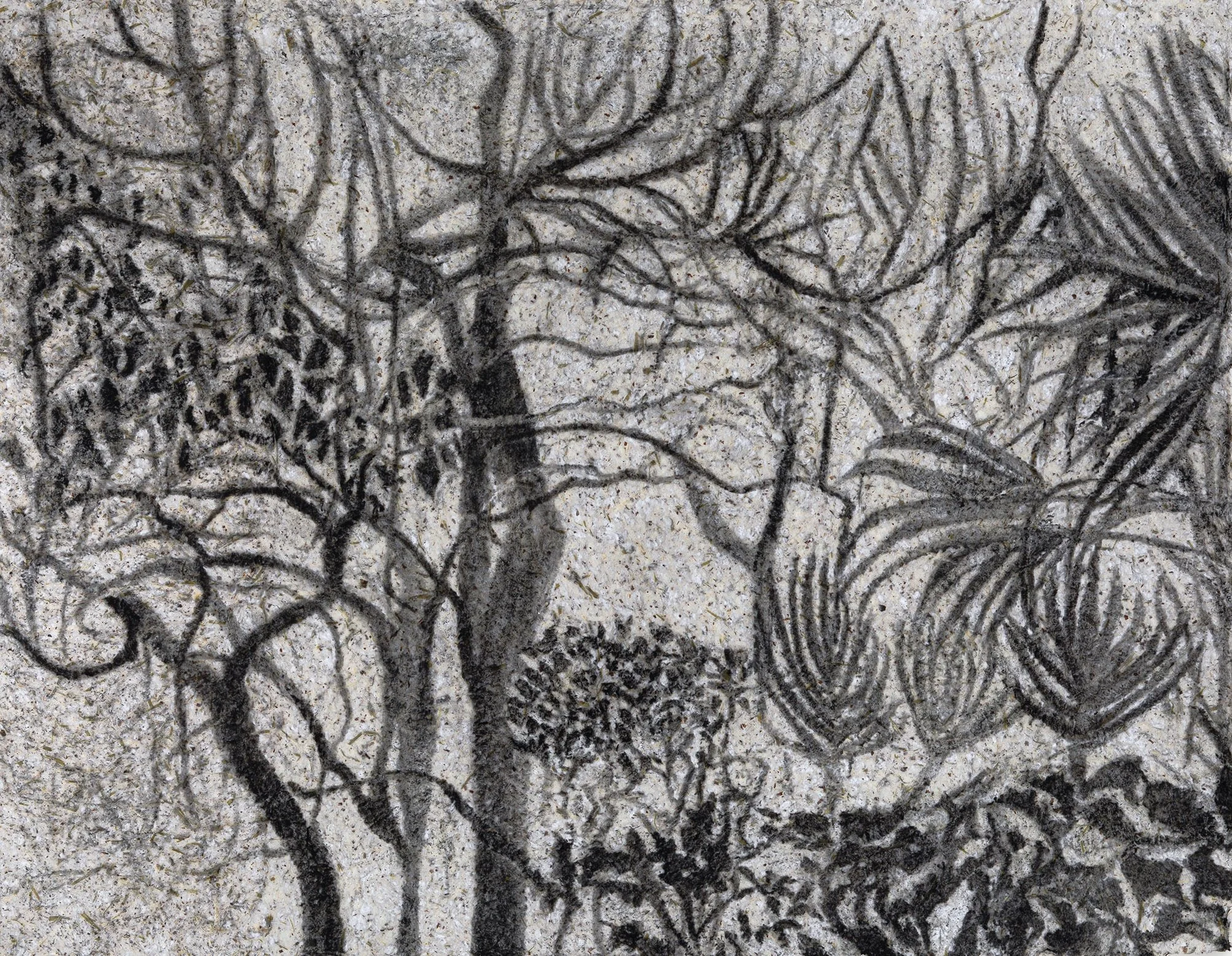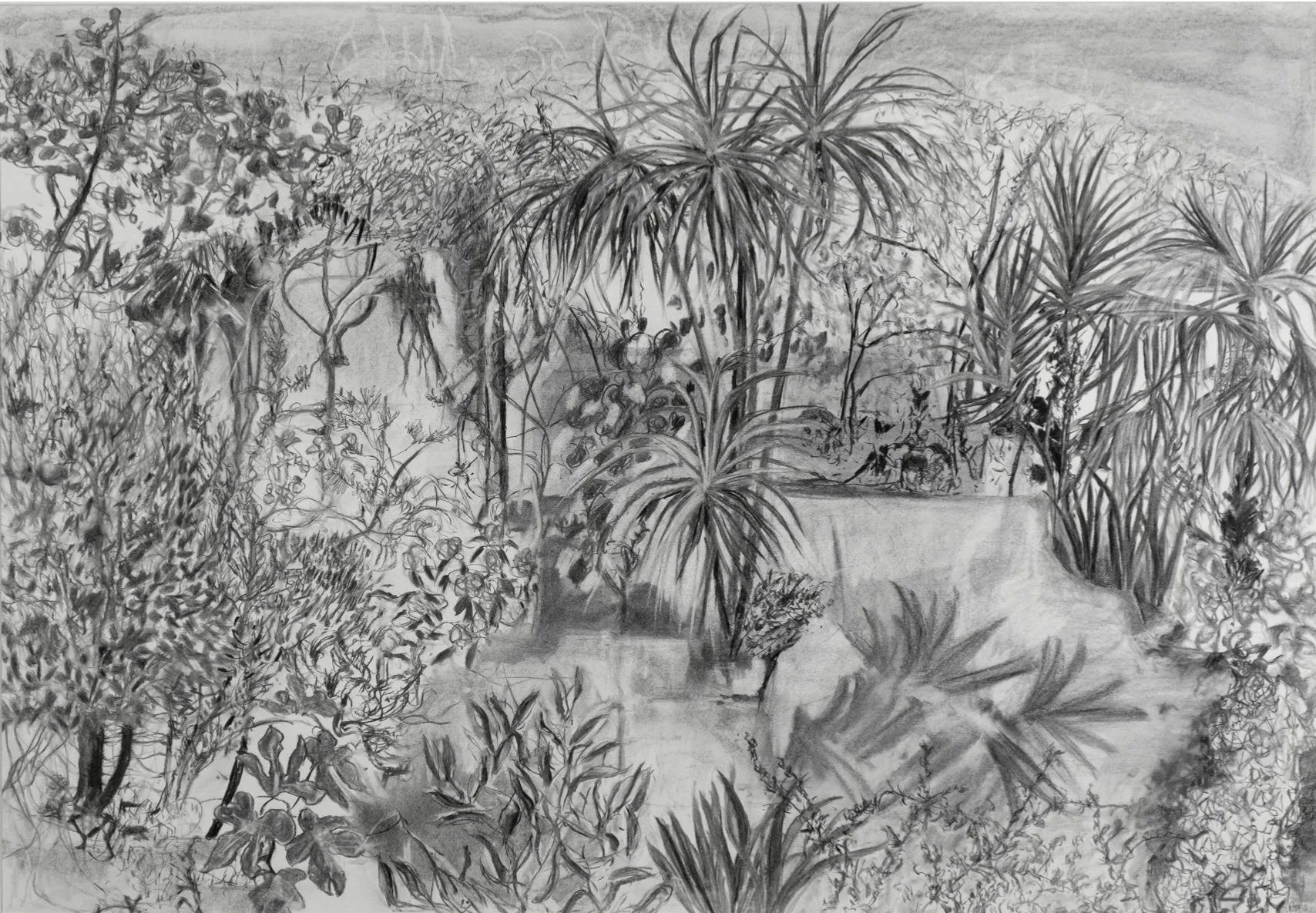CHARCOAL DRAWINGS
These beautiful charcoal drawings are uniquely tied to Royle’s garden because they are produced with plant specific charcoal generated from the actual trees, shrubs and flowers which grow there. Royle gathers stems and branches from palms, pear and fig trees, wisteria and kiwi vines, cuts them into manageable lengths and then bakes them at a high temperature to make her own drawing materials. During the process each species holds onto it’s own particular qualities so palm charcoal keeps its triangular shape which effects how it’s held and hence the quality of mark making, fig is more chunky and crumbly, wisteria is fine and hard with a hint of blue and kiwi stems produce a less dense, very dry charcoal, almost volcanic like lava. With these garden grown materials Royle makes images which hold the memory of their subject and the form of the individual plants within them, so that image and materiality meet. Perhaps most notable for this are the Winter Fig series where fig charcoal is used to draw on handmade fig paper so that Royle enables the fig tree to recreate itself revealing its own fibres, textures, shapes and colours at an almost cellular level.
Some of the drawings are more traditional views of the garden showing dense layers of branches and vigorous foliage woven together in a sensitive and varied show of charcoal blacks, greys and smudged whites. Others are more abstract evoking shady corners and shiny leaves with intense patches of light and dark black alongside dusty greys and the rubbed out whites of the paper.
DISEGNI A CARBONCINO
Questi bellissimi disegni a carboncino sono legati in modo particolare al giardino della Royle, dai cui alberi, arbusti e fiori è generato uno specifico carbone vegetale usato per produrre le opere. La Royle raccoglie gli steli e i rami delle palme, dei peri, dei fichi, del glicine e delle viti della pianta di kiwi; in seguito li taglia in pezzi più maneggiabili, per poi cuocerli a temperature elevate, creando così i suoi materiali da disegno. Durante il processo ogni specie conserva le proprie qualità: il carbone della palma mantiene la sua forma triangolare, la quale influisce sull’impugnatura e quindi anche sulla qualità del tratto; il fico è più spesso e friabile; il glicine invece è più fine, duro e presenta un tocco di blu; i rami di kiwi producono un carbone meno denso, molto secco, paragonabile alla lava vulcanica. Con questi materiali coltivati nel suo giardino, la Royle crea immagini che conservano la memoria del loro soggetto e la forma delle singole piante al loro interno, dando vita a un incontro tra immagine e materialità. Forse quella più notevole in questo aspetto è la serie Fichi Invernali, in cui il carbone di fico viene utilizzato per disegnare sulla carta di fico prodotta a mano: attraverso questo la Royle consente all'albero di fico di ricrearsi mostrando le proprie fibre, la propria texture, le sue forme e i suoi colori a livello quasi microscopico.
Alcuni dei disegni mostrano viste più tradizionali del giardino, in cui si raffigurano densi strati di rami e di fogliame rigoglioso intrecciati in uno spettacolo vivo e vario di neri-carboncino, grigi e bianchi sfumati. Altri invece sono più astratti: qui si evocano angoli ombrosi e foglie lucenti attraverso intense macchie di luce e di buio, accostate a grigi polverosi e bianchi nati laddove qualcosa è stato cancellato.
Untitled Charcoal on card. 48 x 28 cm
Untitled Charcoal on paper. 30 x 42 cm
Winter Fig 1 Fig charcoal on fig paper. 25 x 25 cm
Untitled
Dogwood charcoal on watercolour paper 76 x 56 cm
Untitled Charcoal on paper 58 x 40 cm
Winter Fig 2 Fig charcoal on fig paper 49 x 38 cm
Untitled Charcoal on paper 100 x 70 cm










